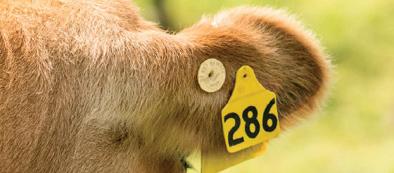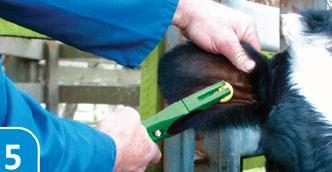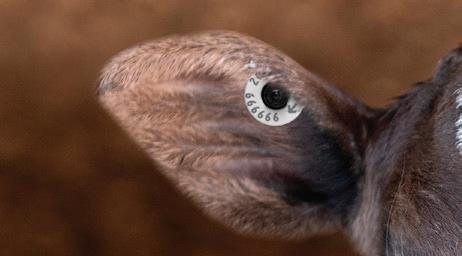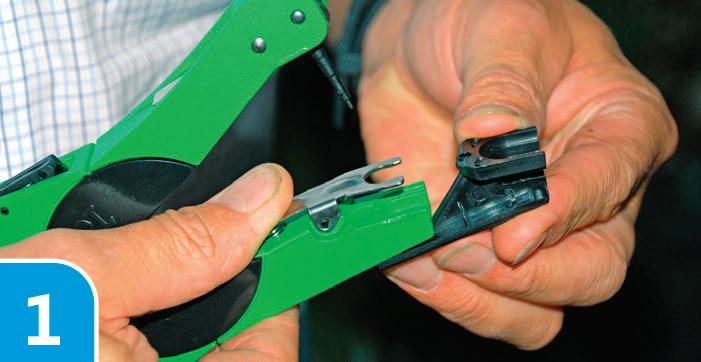
9 minute read
Optimising cow nutrition to improve fertility
Reproductive failure and low calving rates are the most significant wastage factors in many New Zealand herds, with significant negative financial and genetic down-stream affects.
Lost animals must be replaced, either by being purchased or from rearing surplus replacements. In this situation, often cows that should be culled are retained which inevitably changes the age structure of the herd, bringing with it an increased risk of metabolic disease, mastitis and other complicating factors. In most cases poor reproductive performance is influenced by:
Poor or lack of transition (springer cow) management
Post calving diet —quality and quantity
Body condition score at calving
The rate and scale of body condition loss from calving to mating.
There is no doubt that good transition management can help reduce the risk of metabolic disease and the associated risk of metritis. Cows with milk fever are 1.7 times more likely to contract metritis which can negatively impact reproductive performance. Milk fever (both clinical and sub-clinical) can also affect the cow’s ability to quickly reach their peak dry matter intake, causing an increase in the time they spend in negative energy balance. Therefore, minimising issues at calving can go a long way to improving cow fertility. In addition, a good post calving diet directly impacts the amount of energy
| Good transition and post calving management can assist in minimising the risk of metabolic disease and metritis.
available to the cow. Where feed and or feed quality is limited, consider complementing high protein pastures with high energy feeds such as grains, maize or whole crop silage, tapioca and/or fodder beet. Often when using high energy supplements, rumen modifiers such as Levucell ® SC and Rumensin ® have been shown to yield a significant return on investment through improved rumen health and feed conversion efficiencies. Rumensin ® also has other benefits including aiding in the control and reduction of ketosis, acidosis and bloat. Feeding strategies in early lactation can help improve fertility, so seeking assistance from your local Nutritech Area Manager can help you find the best strategy for your farm system. One useful tool used for managing feed and nutrient supply to dairy cows in early lactation is rumen protected fats. Trials with protected fats during early lactation have demonstrated improvements in milk yield, milk composition and fertility. The benefit to fertility comes from improvements in energy balance in the lead up to, and just after mating, with Golden Flake ® being a popular choice for many New Zealand farmers. Feeding rates for fats should be at least 200g per head a day for them to have any appreciable effect on energy supply, milk production and fertility. When considering a bypass fat, there are many different types and they don’t all have the same affect. Lastly it is important to ensure optimal antioxidant and trace element status in dairy cows at mating. This helps to ensure the developing egg and follicle are protected to reduce the risk of early embryonic loss. Nutritech has a Mating Boost Pack that provides cobalt, organic copper, elevated iodine and selenium, organic zinc and Melofeed ® , a unique and powerful primary antioxidant.
Contact your local Farmlands store to arrange an on-farm consultation with your local Nutritech Area Manager.
Rumensin® is a Registered pursuant to the ACVM Act 1997, No A011062. Butler W,R. & Smith, R.D (1989), Fergusen et al., (1989)
Have I Ordered the Correct Tags?
ALL ANIMALS THAT ARE BORN ON FARM MUST HAVE A BIRTH ID NAIT TAG.
HD X Cattle & Deer
Use these tags if -
You weigh your stock regularly You have automation in your dairy shed Your animals will be joining the milking herd
FD X Cattle & Deer
EID Sheep & Go at T ags
Lightweight Sheep & Go at Ta gs
Use these tags if -
You don’t weigh your stock regularly Your animals are going direct to the slaughter or sale yards No NAIT levy on Deer tags at store level.
All RapID tags are HDX so have a higher quality reading and are the most popular electronic sheep tag on the market. Cost of ID number printing included in price. Printing compulsory. RapID tags are to be in ordered in strips of 20. RapID tag colour options are:

Applicator used to apply RapID tags is the RapIDmatic tagger.
The lightweight EID tag is tamperproof and ideally suited for sheep and goats. Can also be applied to young animals. Female tag comes in either yellow or orange and the male tag comes in a range of colours, to suit your management groups .
Lightweight sheep tags can be applied with the identiplier or a universal applicator.
EID Lazamatic

Universal Identiplier
Quick Reminder
All animals born on a farm must have birth ID tags
Rapid Tagger RapIDmatic Tagger Identiplier Universal
Check NAIT Number Check Colour Check Year Born Check Species Check Number Range Check Applicator is Correct

















THE FARMLANDER | 35 WWW.FARMLANDS.CO.NZ Farmlands Co-operative Society Limited | © October 2020. All rights reserved. NAIT Electronic (EID) Tags INSTRUCTIONS FOR THE APPLICATION OF Remember: “Right is Right”. It is recommended that NAIT tags are applied to the animal’s right ear to achieve the best performance on farm. IMPORTANT: Remove/slide black insert out of female jaw. Hold raised area of tag between thumb and forefinger, depress spring clip and insert tag. Dip the applicator into antiseptic or disinfectant solution. Correct position in the ear deer are placed 25mm closer to the head than centre of the ear to allow for future application of visual management tags. It is important that the tag is placed between the two ribs in the ear.IMPORTANT: ‘Free Air Space’ will aid healing and retention. tagging to ensure there is sufficient air space between the ear and the EID tag. 1 2 4 With the correct position located, apply the tag firmly, always with the male tag entering from the back of the ear. 5 NAIT Electronic (EID) Tags INSTRUCTIONS FOR THE APPLICATION OF Remember: “Right is Right”. It is recommended that NAIT tags are applied to the animal’s right ear to achieve the best performance on farm. IMPORTANT: Remove/slide black insert out of female jaw. Hold raised area of tag between thumb and forefinger, depress spring clip and insert tag. Dip the applicator into antiseptic or disinfectant solution. Correct position in the ear deer are placed 25mm closer to the head than centre of the ear to allow for future application of visual management tags. It is important that the tag is placed between the two ribs in the ear. IMPORTANT: tagging to ensure there is sufficient air space between the ear and the EID tag. Correct position for EID Birth Packs Female tags must ALWAYS be at the front/inside of the ear. The management Birth tag can be applied slightly closer to the head, this will allow room for the larger management/cow tags later in the heifer’s life. IMPORTANT: Failure to read this may result in tag damage. Position the tag so the raised area of the tag is at the front or open end of the applicator. The raised area of the tag must be at the front of the applicator during application otherwise damage may occur to the tag componentry. Indentiplier (Green) electronic tag applicators can be used to apply Allflex electronic ear tags, along with the EID Lazamatic (Orange and Red) – the safest applicator to use when tagging in a race. 1 2 4 With the correct position located, apply the tag firmly, always with the male tag entering from the back of the ear. 5 For further help contact your local Farmlands store today. NAIT Electronic (EID) Tags INSTRUCTIONS FOR THE APPLICATION OF Remember: “Right is Right”. It is recommended that NAIT tags are applied to the animal’s right ear to achieve the best performance on farm. IMPORTANT: Remove/slide black insert out of female jaw. Hold raised area of tag between thumb and forefinger, depress spring clip and insert tag. Dip the applicator into antiseptic or disinfectant solution. Correct position in the ear – It is recommended that all EID devices for cattle and deer are placed 25mm closer to the head than centre of the ear to allow for future application of visual management tags. It is important that the tag is placed between the two ribs in the ear. IMPORTANT: ‘Free Air Space’ will aid healing and retention. Inspect placement after tagging to ensure there is sufficient air space between the ear and the EID tag. Correct position for EID Birth Packs Female tags must ALWAYS be at the front/inside of the ear. The management Birth tag can be applied slightly closer to the head, this will allow room for the larger management/cow tags later in the heifer’s life. IMPORTANT: Failure to read this may result in tag damage. Position the tag so the raised area of the tag is at the front or open end of the applicator. The raised area of the tag must be at the front of the applicator during application otherwise damage may occur to the tag componentry. Universal (Red) and Indentiplier (Green) electronic tag applicators can be used to apply Allflex electronic ear tags, along with the EID Lazamatic (Orange and Red) – the safest applicator to use when tagging in a race. 1 2 3 Slip male tag completely onto applicator pin. 4 With the correct position located, apply the tag firmly, always with the male tag entering from the back of the ear. 5 P For further help contact your local Farmlands store today.



FARMLANDS AGFEST EVERY INCH OF THE FARM COVERED

From inputs to infrastructure, knowledge and advice. Come to our tent first!
WHEN:
WHERE: 13 th - 14 th November 2020 Farmlands AgFest, Greymouth Aerodrome
ADMIT ONE
ADMIT ONE
BEAT THE QUEUES AND GET YOUR TICKETS IN-STORE! *
Adult Day Pass $ 9
Child Day Pass $ 4
*Terms and Conditions apply. Purchase your tickets early at Farmlands Westport, Greymouth or Hokitika. Shareholder price is only available in-store.











